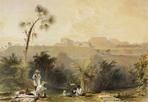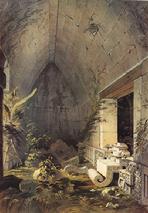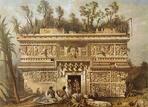E-mail: info@casa-catherwood.com
Correo Electronico: info@casa-catherwood.com
|
|
Frederick Catherwood's Lithographs
|
ONE DAY IN 1839, two intrepid explorers – one English, Frederick Catherwood, and the other American, John Lloyd Stephens – climbed the crumbling steps of the pyramids in the Maya city of Copán. The pyramids had been overgrown by the jungle and their origins forgotten by the inhabitants of the region. The two were the first Westerners to be aware of what was before them as they explored the immense terraces, the magnificent temples and the palaces that had been mysteriously abandoned centuries earlier.
The city had been ignored by the Spanish conquistadors and had fallen into oblivion as it was slowly swallowed up by the luxuriant vegetation of the tropical forest. Human footsteps echoed once more between the crumbling walls of those extraordinary buildings as, filled with excitement, the pair studied inscriptions in an incomprehensible language, ran their hands over stone carvings and stuccoes created with superb workmanship and explored darkened rooms with the help of flickering oil lamps.
That episode in 1839 changed the lives of the two men and meant that the history of the civilizations of Central America had to be rewritten, for on that day, among the stelae raised by the ancient lords of Copán, the Maya came back to life.
Click on thumbnails below to see larger images and read a description of each image.
|
 |
| Plate 1, Idol at Copán |
|
 |
| Plate 2, Pyramidal Bulding and Fragments of Sculpture at Copán |
|
 |
| Plate 3, Back of an Idol at Copán |
|
 |
| Plate 4, Broken Idol at Copán |
|
 |
| Plate 5, Idol and Altar at Copán |
|
 |
| Plate 6, General View of Palenque |
|
 |
| Plate 7 (top), Principal Court of the Palace at Palenque |
|
 |
| Plate 7 (bottom), Interior of Casa III at Palenque |
|
|
|
Later, Stephens and Catherwood also discovered the ruins of Palenque, Uxmal, Chichén Itzá, Kabah, Sayil and many other cities overgrown by the forest. They brought to light the magnificent remains of a refined civilization that had inexplicably disappeared. Theirs was one of the most extraordinary archaeological adventures of all times and we shall journey through it with them thanks to the talent of Frederick Catherwood, the superb illustrator of the two travel diaries written by Stephens published in 1841 and 1843. For the first time, hte stunning hand-colored images Catherwood himself selected for publication in “Views of Ancient Monuments in Central America, Chiapas and Yucatan,” a portfolio of twenty-six lithographs considered to be his masterpieces, are on view at Casa Frederick Catherwood.
Click on thumbnails below to see larger images and read a description of each image.
|
 |
| Plate 8, General View of Las Monjas at Uxmal |
|
 |
| Plate 9, Ornament over the Principal Doorway, Casa del Gobernador, Uxmal |
|
 |
| Plate 10, Archway, Casa del Gobernador, Uxmal |
|
 |
| Plate 11, Gateway of the Great Teocallis, Uxmal |
|
 |
| Plate 12, Ornament Over the Gateway of the Great Teocallis, Uxmal |
|
 |
| Plate 13, General View of Uxmal, Taken from the Archway of Las Monjas, Looking South |
|
 |
| Plate 14, Portion of a Building, Las Monjas, Uxmal |
|
 |
| Plate 15, Portion of La Casa de Las Monjas, Uxmal |
|
|
|
Frederick Catherwood remains an enigma to this day. First of all, we do not know what the man looked like: not a single picture of Catherwood exists today. Secondly, it is almost impossible to discover any personal details about the man or his personality. Even his most intimate friends have not left us a line about his character; he was the friend of great poets and artists but he was not referred to by any of them unless fleetingly. And yet Catherwood was an architect, an artist worthy of being a member of the Royal Academy and, above all, an archaeologist and explorer who made extraordinary discoveries.
Even more disconcerting is the fact that of his enormous graphical, pictorial and cartographic output – hundreds of examples from views of Rome and Jerusalem to the ruins of ancient Egypt and classical Greece – only a fraction has survived, which deals almost exclusively with the Maya ruins of Central America. Modest to excess, Catherwood did very little to bring himself to public notice or to recognize the value of his work; however, it is also true that several of his contemporaries may have been able to benefit from his pathological reserve.
What has remained, however, is enough to show incontrovertibly that Frederick Catherwood was an exceptional documenter and an extraordinary artist. He had a spirit in which the flame of curiosity, knowledge and culture burnt bright.
Casa Frederick Catherwood is a tribute to one of the major figures of the 19th century who inexplicably remained in the shadow until recent times and whose splendid work is almost unknown to the general public.
Click on thumbnails below to see larger images and read a description of each image.
|
 |
| Plate 16, General View of Kabáh |
|
 |
| Plate 17, Interior of the Principal Building at Kabáh |
|
 |
| Plate 18, Well and Building at Sabactsche |
|
 |
| Plate 19, Gateway at Labnah |
|
 |
| Plate 20, Well at Bolonchen |
|
 |
| Plate 22, Teocallis, at Chichén-Itzá |
|
 |
| Plate 21, Las Monjas, Chichén-Itzá |
|
 |
| Plate 23, Castle, at Tuloom |
|
 |
| Plate 24, Temple, at Tuloom |
|
 |
| Plate 25, Colossal Head, at Izamal |
|
|
|
"Views of Ancient Monuments in Central America, Chiapas and Yucatan" is on permanent exhibition at Casa Frederick Catherwood
We are located at Calle 59 #572, just steps west of the Church of Santiago in Merida's historic center.
|
|